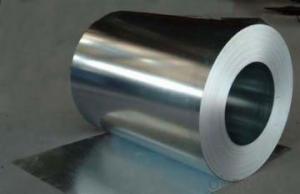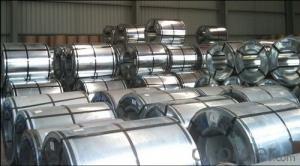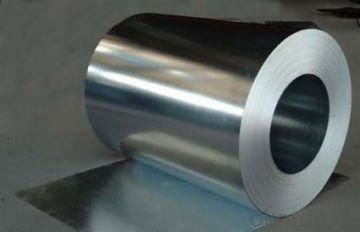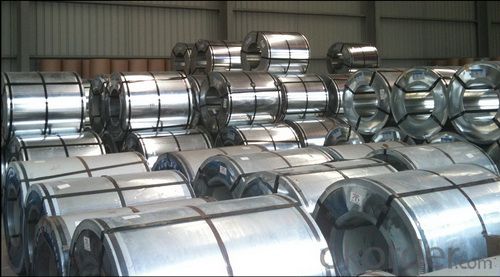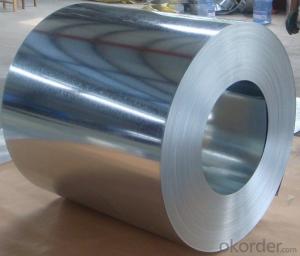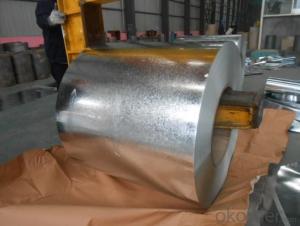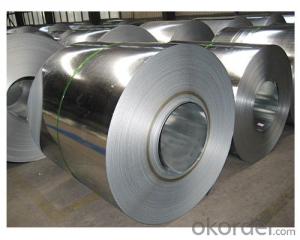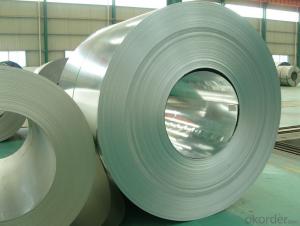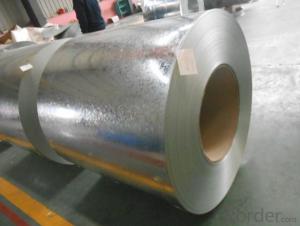Galvanized Steel Sheet in Ciols with Best Prime Quality
- Loading Port:
- Shanghai
- Payment Terms:
- TT OR LC
- Min Order Qty:
- 100 m.t.
- Supply Capability:
- 10000 m.t./month
OKorder Service Pledge
OKorder Financial Service
You Might Also Like
1.Structure of Galvanized Steel Coil Description:
The hot dip process is the process by which steel gets coated in layers of zinc to protect against rust.
It is especially useful for countless outdoor and industrial applications.
2.Main Features of the Galvanized Steel Coil:
• Base material for countless outdoor and industrial applications
• High corrosion resistance
• High strength
• Good formability
• Rust- proof ability
• Good visual effect
3.Galvanized Steel Coil Images
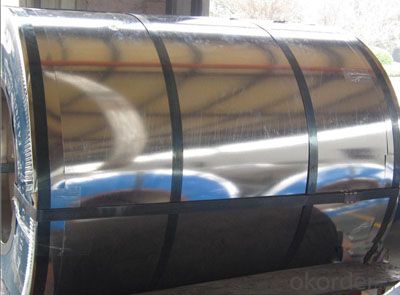
4.Galvanized Steel Coil Specification
Operate Standard: ASTM A653M-04/JIS G3302/DIN EN10143/GBT 2518-2008
Width:914-1250mm(914mm, 1215mm,1250mm,1000mm the most common) Coil id:508mm/610mm Coil weight: 4-10 MT(as required) Grade : SGCD,SGCH, Q195,DX51D
Zinc coating :40-180g( as required)
Surface: regular/mini/zero spangle, chromated, skin pass, dry etc.
5.FAQ of Galvanized Steel Coil
We have organized several common questions for our clients,may help you sincerely:
1.How long can we receive the product after purchase?
Usually within thirty working days after receiving buyer’s advance payment or LC. We will arrange the factory manufacturing as soon as possible. The cargo readiness usually takes 15-25 days, but the shipment will depend on the vessel situation.
- Q: How are steel coils processed for slitting or edge trimming?
- Steel coils are processed for slitting or edge trimming by feeding them into a machine called a slitter. The slitter cuts the coils into narrower strips, which are then rewound onto separate spools. Edge trimming is done to remove any irregularities or imperfections from the edges of the strips, ensuring a smooth and uniform finish.
- Q: I need the measurements of the height and hypotenuse of the first drop in the Steel Dragon 2000. I couldn't find it anywhere. It would be great if you could also show me the website where you got your answer. Thanks! =]*The hypotenuse is the length of the drop.*
- Steel Dragon 2000 is a roller coaster at Nagashima Spa Land Amusement Park in Mie Prefecture, Japan. Built by Morgan Manufacturing, this gigacoaster opened, appropriately, in 2000 - The Year of the Dragon in the Far East. It debuted only months after Millennium Force and surpassed the Cedar Point coaster as the world's tallest complete-circuit coaster. It also set a record for longest track length - 8133 feet, 2 inches (2479 m), which it currently holds. Coaster Facts * Steel Dragon 2000 is the tallest coaster to utilize a traditional chain lift. Because of the length of the lift hill, two chains are used - one for the bottom half and one for the top half. A single chain would have been excessively long and heavy, at least twice the weight of one of the trains. As a result, two trains can safely occupy the lift simultaneously. * The building of Steel Dragon 2000 required far more steel than other coasters for earthquake protection. This put the cost of the coaster at over $50,000,000. * On August 23, 2003, Steel Dragon 2000 was involved in an accident during a run in which one of its trains lost a wheel. The coaster did not operate during the 2004 and 2005 park seasons. It reopened September 3, 2006.
- Q: What are the dimensions of steel coils used in the storage system industry?
- The dimensions of steel coils used in the storage system industry can vary depending on the specific requirements and applications. However, there are some common dimensions that are widely used. The most common coil width ranges from 600mm to 2000mm, although it can be as narrow as 100mm or as wide as 2500mm in certain cases. The coil thickness typically ranges from 0.5mm to 6mm, but it can go up to 25mm for specialized applications. The inner diameter of the coil, known as the core diameter, is usually between 508mm and 610mm. The weight of steel coils can vary significantly depending on the width, thickness, and length of the coil. However, a standard steel coil can weigh anywhere from 3 to 20 tons. It is important to note that these dimensions are not fixed and can be customized based on the specific storage system requirements and the industry in which they are used.
- Q: Edward Humphrey wants to know... Can I use steel roofing on an older house?
- steel roofing is a very logical option when considering replacing a residential roof. Keep in mind that in addition to the cost of the actual metal roofing panel, most likely, in order to qualify for the warranties associated with these products, you must also use their accessories and adhere strictly to their installation instructions. If you have a very cut up house, lots of dormers and valleys, etc, the costs to waterproof these areas before installing can get to be costly, but as far as a straight forward reroof over existing substrate, costs are very competitive. As much as I see a lot recommend going over existing shingles, I prefer to strip the existing shingles, and check the sheathing, before waterproofing and roof installation.
- Q: What are the common surface defects in steel coils?
- Common surface defects in steel coils include scratches, pits, indentations, stains, and rust spots. Scratches can occur during handling or processing of the steel coils and can vary in depth and length. Pits are small depressions on the surface of the coil and can be caused by impurities in the steel or during the manufacturing process. Indentations are similar to pits but are usually larger and more noticeable. Stains can be caused by various factors such as chemicals, water, or other contaminants coming into contact with the steel surface. Rust spots occur when the steel is exposed to moisture or corrosive elements, leading to the formation of iron oxide. These defects can affect the appearance, quality, and performance of the steel, and it is important to address them to ensure the desired end-use of the coils.
- Q: How are steel coils inspected for surface defects after processing?
- Steel coils are inspected for surface defects after processing using various methods such as visual inspection, magnetic particle inspection, dye penetrant inspection, and ultrasonic testing. These techniques help identify any irregularities or defects on the surface of the coils, ensuring the quality and integrity of the final product.
- Q: What are the different types of steel coil packaging materials?
- There are several different types of steel coil packaging materials, including steel strapping, stretch film, plastic wrap, metal bands, and wooden crates. These materials help protect and secure steel coils during transportation and storage.
- Q: I am a beginner and have a slow to average swing speed. Should i get graphite or steel shafts for my irons and does it make a difference?
- How about graphite in your 3,4,5 irons and lightweight steel in your scoring clubs. You can swingweight them all the same so you will have a consistent feel through out the entire set and you will get extra help getting the ball in the air with the long irons and extra stability in the scoring clubs. And you save money by not having to put graphite in the entire set. As a beginner the clubs you get now may not suit you as you progress and your swing evolves so keep this in mind when buying a set of irons.
- Q: which elements are alloyed to make stainless steel?A Fe, CB Fe, MnC Fe, NiD Fe, CrE Fe, Cr, Ni
- E. Stainless steel is mainly comprised of Cr and Ni. Steel is an alloy composed mainly of iron. On a side note, Carbon is not really in stainless steel and it is only less than .1%
- Q: How are steel coils used in the production of appliances?
- Steel coils are used in the production of appliances as a primary material for constructing the various components, such as the outer shells, frames, and internal structures. The coils are processed and shaped into specific sizes and forms to meet the requirements of different appliances. Additionally, steel coils provide strength, durability, and a sleek appearance to the finished appliances.
Send your message to us
Galvanized Steel Sheet in Ciols with Best Prime Quality
- Loading Port:
- Shanghai
- Payment Terms:
- TT OR LC
- Min Order Qty:
- 100 m.t.
- Supply Capability:
- 10000 m.t./month
OKorder Service Pledge
OKorder Financial Service
Similar products
Hot products
Hot Searches
Related keywords
